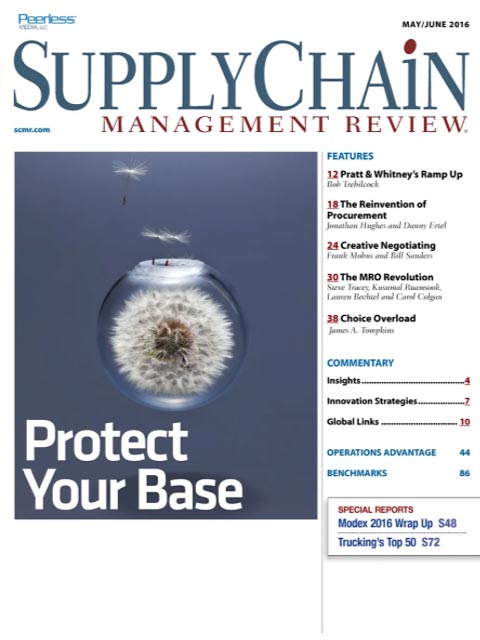Sorry, but your login has failed. Please recheck your login information and resubmit. If your subscription has expired, renew here.
May-June 2016
The procurement function is at an inflection point.” So begins “The reinvention of procurement," an article by Jonathan Hughes and Danny Ertel, partners at the Boston-based consulting firm Vantage Partners. The authors argue that while many leading companies have transformed their procurement organizations into a linchpin of their enterprise strategy, far too many others remain trapped by procurement models that are out of date in today’s fastpaced economy, where the acquisition of innovation, collaboration, services and solutions is more important than transactions based on the lowest cost per unit. Reinvention is a fitting theme for… Browse this issue archive.Need Help? Contact customer service 847-559-7581 More options
Purchasers need to find new ways of dealing with suppliers. It is commendable that so many procurement professionals have moved beyond the long-held transactional orthodoxies that pitted suppliers against one another to negotiate lower prices. Many of those pros now favor long-term agreements (LTAs) that yield better pricing because they allow the purchasers to concentrate their firepower on a few key suppliers. There are further benefits from lower transaction costs: fewer individual supplier files and scorecards to manage, for one thing. Equally important, purchasers can carve out the time for deep value creation that goes beyond price concessions and total-cost-of-ownership reduction alone.
Yet LTAs are not the automatic answer either. With several decades of LTA history behind us (remember, U.S. carmakers were forging strategic agreements with selected tier one sup¬pliers back in the 1980s, for instance), we can see how easy it is for LTAs to fall short of their original objectives.
In fact, what seems like golden opportunities to minimize materials and transaction costs and cre¬ate more value can quickly become golden hand¬cuffs. When purchasers fail to adapt their negotiating approaches to align with changes in their supply chain strategies or to accommodate shifts in the supply base, suppliers on which purchasing organizations have come to depend can sometimes become complacent. Advantages achieved by the supply chain organization can swiftly dissipate.
 |
This complete article is available to subscribers
only. Click on Log In Now at the top of this article for full access. Or, Start your PLUS+ subscription for instant access. |
SC
MR
Sorry, but your login has failed. Please recheck your login information and resubmit. If your subscription has expired, renew here.
May-June 2016
The procurement function is at an inflection point.” So begins “The reinvention of procurement," an article by Jonathan Hughes and Danny Ertel, partners at the Boston-based consulting firm Vantage Partners.… Browse this issue archive. Access your online digital edition. Download a PDF file of the May-June 2016 issue.
 |
Download Article PDF |
Purchasers need to find new ways of dealing with suppliers. It is commendable that so many procurement professionals have moved beyond the long-held transactional orthodoxies that pitted suppliers against one another to negotiate lower prices. Many of those pros now favor long-term agreements (LTAs) that yield better pricing because they allow the purchasers to concentrate their firepower on a few key suppliers. There are further benefits from lower transaction costs: fewer individual supplier files and scorecards to manage, for one thing. Equally important, purchasers can carve out the time for deep value creation that goes beyond price concessions and total-cost-of-ownership reduction alone.
Yet LTAs are not the automatic answer either. With several decades of LTA history behind us (remember, U.S. carmakers were forging strategic agreements with selected tier one sup¬pliers back in the 1980s, for instance), we can see how easy it is for LTAs to fall short of their original objectives.
In fact, what seems like golden opportunities to minimize materials and transaction costs and cre¬ate more value can quickly become golden hand¬cuffs. When purchasers fail to adapt their negotiating approaches to align with changes in their supply chain strategies or to accommodate shifts in the supply base, suppliers on which purchasing organizations have come to depend can sometimes become complacent. Advantages achieved by the supply chain organization can swiftly dissipate.
 |
SUBSCRIBERS: Click here to download PDF of the full article. |
SC
MR

Latest Supply Chain News
- AI, virtual reality is bringing experiential learning into the modern age
- Humanoid robots’ place in an intralogistics smart robot strategy
- Tips for CIOs to overcome technology talent acquisition troubles
- There is still work to do to achieve supply chain stability
- Blooming success: The vital role of S&OE in nurturing global supply chains
- More News
Latest Resources

 Explore
Explore
Latest Supply Chain News
- AI, virtual reality is bringing experiential learning into the modern age
- Humanoid robots’ place in an intralogistics smart robot strategy
- Tips for CIOs to overcome technology talent acquisition troubles
- There is still work to do to achieve supply chain stability
- Blooming success: The vital role of S&OE in nurturing global supply chains
- Supply chain salaries, job satisfaction on the rise
- More latest news
Latest Resources

Subscribe

Supply Chain Management Review delivers the best industry content.

Editors’ Picks





